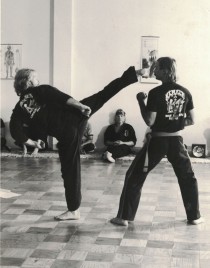What Belt Are You?

WHAT BELT ARE YOU?
For some unknown reason (to me), learning defensive shooting skills is viewed differently than other martial skills. If I asked what learning boxing or karate looked like, most would describe a process that included, at a minimum, weekly training over an extended period.
As a kid, when I walked into the Dojo and asked about Karate lessons, I was told it took 2-5 years to earn a black belt and only 1/100 would train to that level; challenge accepted. Most martial arts use a colored belt system to define skill levels. These belts identify, at a glance, an individual’s minimum skill to other practitioners. There are several benefits; it sets a goal; it gives a reference or example of what that skill level looks like to those trying to attain that rank. Usually, it is also clearly defined what you must do to attain the promotion.
This is not the case when it comes to learning to shoot. When you find your shooting instructor, there is little to tell you what his/her skill level is. When you sign up for martial arts, you want to learn from the black-belt, not the white-belt. The thought process is often that if you complete a one day NRA Basics of Pistol class you are going to leave with the necessary skills to protect yourself. You are not. I’m not picking on the NRA, it’s true of all one day classes, or two day classes, or week long classes.
When I started learning defensive shooting skills, my background in martial arts prepared me for the long process of learning to shoot well. Not to mention preparing me with the proper mental conditioning.
What is your shooting level? Beginner? Intermediate? Advanced? Nobody likes to be thought of as a beginner, especially men. Louis Awerbuck famously asked “what is an advanced gunfight?” I get it, but we need to get the proper level of training to progress and not be in over our heads. We need to be in it for the long haul. We should have a goal and a plan to reach it.
The IPSC/USPSA shooting games uses a letter system to identify minimum skills. From U, (unclassified), D,C,B,A,M to GM, (Grand Master). IDPA uses a title, Novice, Marksman, Sharpshooter, Expert, Master. I’m a fan of competitive shooting, it will teach you to drive the gun to your max performance. It won’t teach you tactics. But, you will have a measurable platform to identify your skill level and set goals to get better. Originally, IPSC was meant to be “Practical”, (that’s the P in IPSC) but the game moved away from that. IDPA was started to return the practical aspects to competitive shooting, nice try. You don’t need to get into competition to do that though. There are drills out there that you can use to check your skills and to set some goals (check out Live Fire Drill Cards.) Some are good enough they were developed in the defensive shooting arena and carried over into the competitive (the reverse is true too).
What is the minimum skill level, what belt to attain? Once again, with martial arts, there is usually a corresponding belt color to help understand. Different arts will use different colors but; we described blue as the level which a student would start to use their skills as part of a trained response. Knowing the skill is not enough. It must be a trained response to be useful.
Check out this article on that.
Recognize it is a continuing education process, and you will need to commit if you want a reliable skill when the flag flies. Learn how to practice. If you can’t do it slow, you can’t do it fast. As with any physical skill requiring a high degree of hand-eye coordination, you must put effort in to maintaining it. It is a diminishing skill.
What belt are you?
